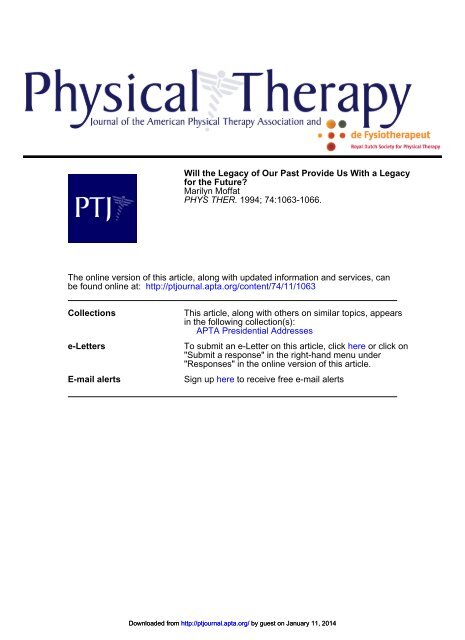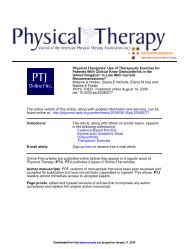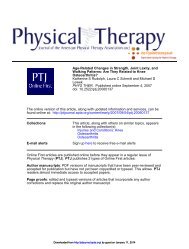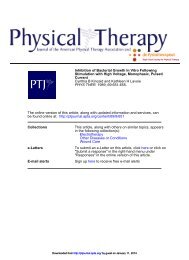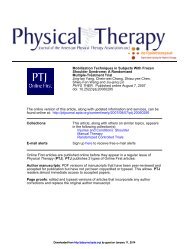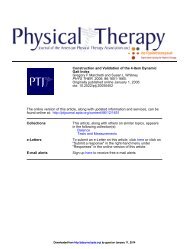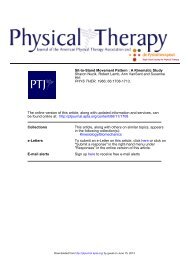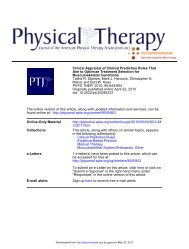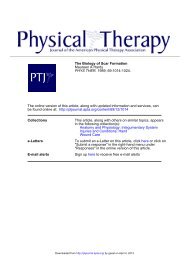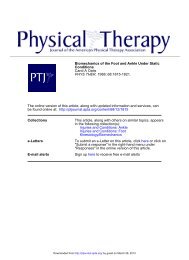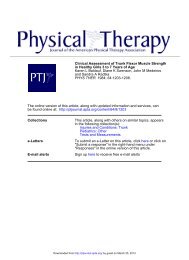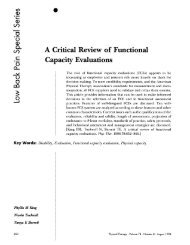Will the Legacy of Our Past Provide Us With a ... - Physical Therapy
Will the Legacy of Our Past Provide Us With a ... - Physical Therapy
Will the Legacy of Our Past Provide Us With a ... - Physical Therapy
Create successful ePaper yourself
Turn your PDF publications into a flip-book with our unique Google optimized e-Paper software.
<strong>Will</strong> <strong>the</strong> <strong>Legacy</strong> <strong>of</strong> <strong>Our</strong> <strong>Past</strong> <strong>Provide</strong> <strong>Us</strong> <strong>With</strong> a <strong>Legacy</strong><br />
for <strong>the</strong> Future?<br />
Marilyn M<strong>of</strong>fat<br />
PHYS THER. 1994; 74:1063-1066.<br />
The online version <strong>of</strong> this article, along with updated information and services, can<br />
be found online at: http://ptjournal.apta.org/content/74/11/1063<br />
Collections<br />
e-Letters<br />
E-mail alerts<br />
This article, along with o<strong>the</strong>rs on similar topics, appears<br />
in <strong>the</strong> following collection(s):<br />
APTA Presidential Addresses<br />
To submit an e-Letter on this article, click here or click on<br />
"Submit a response" in <strong>the</strong> right-hand menu under<br />
"Responses" in <strong>the</strong> online version <strong>of</strong> this article.<br />
Sign up here to receive free e-mail alerts<br />
Downloaded from http://ptjournal.apta.org/<br />
by guest on January 11, 2014
The 1993 APTA Presidential Address<br />
<strong>Will</strong> <strong>the</strong> <strong>Legacy</strong> <strong>of</strong> <strong>Our</strong> <strong>Past</strong> <strong>Provide</strong> <strong>Us</strong><br />
<strong>With</strong> a <strong>Legacy</strong> for <strong>the</strong> Future?<br />
This APTA Presidential Address was presented at <strong>the</strong> Annual Conference <strong>of</strong> <strong>the</strong><br />
American <strong>Physical</strong> <strong>Therapy</strong> Association, Cincinnati, Ohio, fune 12, 1993-<br />
Marilyn M<strong>of</strong>fat<br />
Mr Puller,* colleagues, distinguished<br />
guests—it is indeed my pleasure to<br />
open this meeting <strong>of</strong> <strong>the</strong> American<br />
<strong>Physical</strong> <strong>Therapy</strong> Association in Cincinnati,<br />
Ohio, marking <strong>the</strong> 72nd year<br />
in <strong>the</strong> history <strong>of</strong> <strong>the</strong> Association.<br />
This is a most historic year in <strong>the</strong> life<br />
<strong>of</strong> <strong>the</strong> pr<strong>of</strong>ession <strong>of</strong> physical <strong>the</strong>rapy<br />
because it does mark <strong>the</strong> 75th anniversary<br />
<strong>of</strong> <strong>the</strong> founding <strong>of</strong> <strong>the</strong> first education<br />
program for <strong>the</strong> training <strong>of</strong> physical<br />
<strong>the</strong>rapists in this country. Thus, <strong>the</strong><br />
central <strong>the</strong>me about which this address<br />
will be based is: <strong>Will</strong> <strong>the</strong> legacy<br />
<strong>of</strong> our past provide us with a legacy<br />
for <strong>the</strong> future? To answer that question,<br />
we must look at <strong>the</strong> evolution <strong>of</strong><br />
our pr<strong>of</strong>ession, from what appeared to<br />
us as technical status, to somewhere in<br />
between, and now to <strong>the</strong> brink <strong>of</strong><br />
pr<strong>of</strong>essionalism. And at <strong>the</strong> same time,<br />
we must introspectively review <strong>the</strong><br />
most positive aspects <strong>of</strong> what physical<br />
<strong>the</strong>rapy is all about, critically examine<br />
those divergent paths that will eventually<br />
thwart our dreams and aspirations<br />
<strong>of</strong> pr<strong>of</strong>essionalization if we continue to<br />
pursue <strong>the</strong>m, and idealistically charter<br />
a course to enable us to soar to <strong>the</strong><br />
heights that this pr<strong>of</strong>ession should<br />
attain.<br />
<strong>Our</strong> history related to practice shows<br />
that we evolved because <strong>of</strong> <strong>the</strong> necessity<br />
<strong>of</strong> providing treatment to those<br />
individuals who were wounded during<br />
World War I and to those who suffered<br />
from <strong>the</strong> paralytic effects <strong>of</strong> poliomyelitis.<br />
Although perhaps looked upon as<br />
technical workers, <strong>the</strong> Reconstruction<br />
Aides, who were <strong>the</strong> first physical<br />
<strong>the</strong>rapists, were much, much more<br />
than that. Seventy-five years ago <strong>the</strong>y<br />
were for <strong>the</strong> most part graduates <strong>of</strong><br />
gymnasia or nursing programs and<br />
thus were really postbaccalaureate<br />
certificate individuals. After <strong>the</strong>ir war<br />
service, <strong>the</strong>y embarked into many<br />
varied practice arenas, including hospitals<br />
and private practices. They were<br />
recognized by <strong>the</strong>ir medical colleagues<br />
for <strong>the</strong>ir expertise, and <strong>the</strong>y—and <strong>the</strong>y<br />
alone—provided "physio<strong>the</strong>rapeutic"<br />
services to <strong>the</strong>ir patients.<br />
<strong>Our</strong> history related to education shows<br />
that for over 30 years our education<br />
was in hospital-based and postbaccalaureate<br />
certificate programs in institutions<br />
<strong>of</strong> higher education. Of note was<br />
<strong>the</strong> fact that those who taught in <strong>the</strong><br />
increasing numbers <strong>of</strong> physical <strong>the</strong>rapy<br />
education programs that developed<br />
M M<strong>of</strong>fat, PhD, PT, FAPTA, is President, American <strong>Physical</strong> <strong>Therapy</strong> Association, Ludlam Ln, Locust<br />
Valley, NY 11560 (USA).<br />
*The late Lewis B Puller, Jr, Pulitzer-Prize-winning author <strong>of</strong> Fortunate Son, was <strong>the</strong> keynote<br />
speaker at <strong>the</strong> Opening Ceremonies <strong>of</strong> <strong>the</strong> 1993 Annual Conference.<br />
[M<strong>of</strong>fat M. The 1993 APTA Presidential Address. <strong>Will</strong> <strong>the</strong> legacy <strong>of</strong> our past provide us with a legacy<br />
for <strong>the</strong> future? Phys Ther. 1994,74.1063-1066]<br />
after World War I did so because <strong>of</strong><br />
<strong>the</strong> strong education base that <strong>the</strong>y<br />
had had with <strong>the</strong>ir "prephysio<strong>the</strong>rapy"<br />
background. This strongly based educator<br />
dominated physical <strong>the</strong>rapy education<br />
programs throughout <strong>the</strong> first<br />
40 years <strong>of</strong> our history.<br />
What has happened to physical <strong>the</strong>rapy<br />
education and practice since that<br />
time must be reviewed with an openness<br />
and honesty that makes us capable<br />
<strong>of</strong> assessing what appropriate<br />
change is necessary to ensure a legacy<br />
for those who follow us. First, let us<br />
look at education. Somewhere in <strong>the</strong><br />
1960s we decided that we needed<br />
academic legitimacy, so we embarked<br />
upon a program to make <strong>the</strong> baccalaureate<br />
degree <strong>the</strong> minimum degree<br />
for physical <strong>the</strong>rapist education. As<br />
one could easily expect, <strong>the</strong> minimum<br />
became <strong>the</strong> norm. Thus, when 20<br />
years later we tried to return to <strong>the</strong><br />
postbaccalaureate mode, great resistance<br />
occurred both within and without<br />
<strong>the</strong> physical <strong>the</strong>rapy educational<br />
community. And 14 years after our<br />
decision to move to postbaccalaureate<br />
education, we are still struggling with<br />
where physical <strong>the</strong>rapy education<br />
should be. Many <strong>of</strong> our faculty within<br />
our educational arenas do not have<br />
<strong>the</strong> strong pedagogical background<br />
for <strong>the</strong>ir teaching responsibilities and<br />
for <strong>the</strong>ir roles in higher education<br />
that our predecessors had. And in<br />
spite <strong>of</strong> <strong>the</strong> problems in academia,<br />
our programs continue to rival doc-<br />
72/1063<br />
<strong>Physical</strong> <strong>Therapy</strong>/Volume 74, Number 11/November 1994<br />
Downloaded from http://ptjournal.apta.org/ by guest on January 11, 2014
toral programs in quantity <strong>of</strong> material<br />
and quality <strong>of</strong> material, yet we continue<br />
to award baccalaureate or master's<br />
degrees for programs that are so<br />
much more than that.<br />
Let us next look at practice. <strong>Physical</strong><br />
<strong>the</strong>rapy practice certainly has seen<br />
some drastically changing patterns in<br />
its more recent history. From <strong>the</strong> early<br />
treatment <strong>of</strong> <strong>the</strong> war wounded to <strong>the</strong><br />
massive muscle reeducation required<br />
during <strong>the</strong> poliomyelitis epidemics, <strong>the</strong><br />
practice <strong>of</strong> physical <strong>the</strong>rapy appears to<br />
be moving fur<strong>the</strong>r and fur<strong>the</strong>r away<br />
from <strong>the</strong> skills and from <strong>the</strong> types <strong>of</strong><br />
services rendered that had made us<br />
unique. These are <strong>the</strong> same kinds <strong>of</strong><br />
skills and services that made Lt Puller<br />
always remember his physical <strong>the</strong>rapist<br />
and that made him forever aware <strong>of</strong><br />
<strong>the</strong> long-lasting effects <strong>of</strong> his physical<br />
<strong>the</strong>rapy intervention. These are <strong>the</strong><br />
same kinds <strong>of</strong> skills and services that<br />
are not duplicated or rendered by<br />
o<strong>the</strong>rs. What has and where have we<br />
gone awry? Although I firmly believe<br />
that many, many physical <strong>the</strong>rapy practitioners<br />
are attempting to do <strong>the</strong> best<br />
possible, I am increasingly dismayed<br />
when I hear <strong>the</strong> following types <strong>of</strong><br />
comments.<br />
From a colleague in New York came<br />
<strong>the</strong> statement that a patient had been<br />
referred to her <strong>of</strong>fice for spinal stenosis.<br />
Upon taking <strong>the</strong> history, my colleague<br />
found that this patient had<br />
been previously seen by ano<strong>the</strong>r<br />
physical <strong>the</strong>rapist who was a participating<br />
physical <strong>the</strong>rapist in a large<br />
New York City health maintenance<br />
organization (HMO) and who had<br />
seen her initially for 30 visits. Fur<strong>the</strong>r,<br />
<strong>the</strong> patient's treatment had consisted<br />
<strong>of</strong> one exercise, and hot packs and<br />
ultrasound to <strong>the</strong> left thigh because<br />
that is where <strong>the</strong> pain was—remember,<br />
this patient had a diagnosis <strong>of</strong><br />
spinal stenosis. After completing that<br />
course <strong>of</strong> 30 visits, <strong>the</strong> patient was<br />
<strong>the</strong>n given authorization for transcutaneous<br />
electrical nerve stimulation<br />
(TENS) and had 25 more visits with<br />
<strong>the</strong> same physical <strong>the</strong>rapist, who now<br />
applied TENS instead <strong>of</strong> hot packs<br />
and ultrasound and one exercise. This<br />
patient had 55 visits <strong>of</strong> something that<br />
I will not even deign to call physical<br />
<strong>the</strong>rapy. Yet this patient's insurance<br />
paid for physical <strong>the</strong>rapy, and <strong>the</strong><br />
<strong>the</strong>rapist collected for this, what I<br />
might term, disservice.<br />
From ano<strong>the</strong>r colleague in South Dakota<br />
came <strong>the</strong> story <strong>of</strong> her mo<strong>the</strong>r,<br />
who lived in ano<strong>the</strong>r state and who<br />
had undergone a total knee replacement.<br />
Discharged from <strong>the</strong> hospital on<br />
crutches with a continuous passive<br />
motion machine and some home<br />
exercises, <strong>the</strong> patient kept her leg in<br />
extension while doing most activities<br />
<strong>of</strong> daily living. Five weeks postdischarge,<br />
<strong>the</strong> physician finally recommended<br />
outpatient physical <strong>the</strong>rapy,<br />
which included exercises and mobilization<br />
techniques. The manual <strong>the</strong>rapy<br />
techniques used rendered <strong>the</strong> patient<br />
nonambulatory for 2 days after each<br />
treatment. These were certainly not <strong>the</strong><br />
Grade II techniques that might have<br />
served as neuromodulators <strong>of</strong> pain.<br />
After 8 weeks <strong>of</strong> excruciatingly painful<br />
<strong>the</strong>rapy and only 10 degrees <strong>of</strong> increased<br />
range <strong>of</strong> motion, she finally<br />
sought her daughter's advice. Upon<br />
examination, pain, difficulty moving<br />
about, poor balance, decreased step<br />
length, and asymmetrical gait were all<br />
noted, as well as a completely atrophied<br />
gastrocnemius muscle. <strong>With</strong> an<br />
intensive, progressive home program<br />
<strong>of</strong> appropriate streng<strong>the</strong>ning, appropriate<br />
stretching that <strong>the</strong> patient now<br />
happily did herself, gait instruction,<br />
stair climbing, and functional skills<br />
training, this woman is back to her<br />
previous busy, productive life. It is<br />
difficult to justify mobilization techniques<br />
that render <strong>the</strong> recipient so<br />
debilitated as to question <strong>the</strong> efficacy<br />
<strong>of</strong> those techniques, and it is equally<br />
as difficult to justify those particular<br />
manual techniques with a joint replacement<br />
when <strong>the</strong> capsule has not<br />
completely grown back.<br />
From ano<strong>the</strong>r colleague in Illinois<br />
came <strong>the</strong> case <strong>of</strong> a patient who had<br />
undergone a total hip replacement and<br />
who was referred to this <strong>the</strong>rapist for<br />
home health care 9 days after <strong>the</strong><br />
surgery. Upon arrival at <strong>the</strong> house, my<br />
colleague noted quite apparent shortness<br />
<strong>of</strong> breath. She referred <strong>the</strong> patient<br />
back to <strong>the</strong> physician, who evaluated<br />
her and immediately performed an<br />
angiogram, which revealed three totally<br />
occluded vessels. Open-heart<br />
surgery was performed within 2 days,<br />
and 1 week later she was told by <strong>the</strong><br />
nurse in <strong>the</strong> hospital to attend <strong>the</strong><br />
cardiac rehabilitation class. In class,<br />
she was unable to stand from <strong>the</strong><br />
chair, and when asked why by <strong>the</strong><br />
nurse, <strong>the</strong>y finally realized that she had<br />
also just undergone a total hip replacement<br />
3 weeks before. Then <strong>the</strong> difficulty<br />
began—<strong>the</strong> orthopedic physical<br />
<strong>the</strong>rapist would not see her because <strong>of</strong><br />
her cardiac involvement, and <strong>the</strong> cardiac<br />
physical <strong>the</strong>rapist was unable to<br />
provide <strong>the</strong> care for her hip.<br />
From ano<strong>the</strong>r colleague in Texas<br />
came <strong>the</strong> saga <strong>of</strong> a patient with an<br />
on-<strong>the</strong>-job neck injury who had been<br />
treated by a physical <strong>the</strong>rapist authorized<br />
by workers' compensation. The<br />
patient was seen for 1V2 years by <strong>the</strong><br />
physical <strong>the</strong>rapist, and <strong>the</strong> treatment<br />
consisted <strong>of</strong> hot packs, ultrasound,<br />
massage, traction, and electrical stimulation.<br />
Upon being evaluated by my<br />
colleague, V/z years later, this patient<br />
was placed on a progressive physical<br />
<strong>the</strong>rapy exercise program <strong>of</strong> streng<strong>the</strong>ning<br />
and stretching, was given instructions<br />
in activities <strong>of</strong> daily living,<br />
was taught appropriate postural alignment,<br />
was provided with an appropriate<br />
pillow for sleeping, and was seen<br />
once per week for 4 weeks when she<br />
returned to full-time employment.<br />
And from yet ano<strong>the</strong>r colleague in<br />
New Mexico came <strong>the</strong> history <strong>of</strong> a<br />
patient who was referred to her<br />
clinic. The patient, who had a firm<br />
roentgenographic diagnosis <strong>of</strong> a<br />
spondylolis<strong>the</strong>sis, had previously been<br />
seen by ano<strong>the</strong>r physical <strong>the</strong>rapist.<br />
The previous <strong>the</strong>rapist had taken a<br />
course that told him that extension<br />
exercises were <strong>the</strong> way to treat back<br />
problems. <strong>With</strong>out fully assessing <strong>the</strong><br />
pathophysiological and anatomical<br />
changes in spondylolis<strong>the</strong>sis, he embraced<br />
<strong>the</strong> extension approach and<br />
administered only those movements<br />
for this patient. Needless to say, <strong>the</strong><br />
patient did not improve and did experience<br />
worsening <strong>of</strong> symptoms. Upon<br />
<strong>the</strong> new referral to my colleague, <strong>the</strong><br />
patient was placed on an exercise<br />
<strong>Physical</strong> <strong>Therapy</strong>/Volume 74, Number 11/November 1994 1064/73<br />
Downloaded from http://ptjournal.apta.org/ by guest on January 11, 2014
program appropriate for <strong>the</strong> condition<br />
and made steady improvement.<br />
To put aside <strong>the</strong> patient examples for<br />
a moment, I should like to have us<br />
look at o<strong>the</strong>r facets <strong>of</strong> what have appeared<br />
to be changing patterns <strong>of</strong><br />
physical <strong>the</strong>rapy practice, which must<br />
be carefully evaluated in this era <strong>of</strong><br />
fiscal constraint and this era <strong>of</strong> increasing<br />
scrutiny <strong>of</strong> our services.<br />
Have we adjusted our charges to a<br />
client or patient so that if <strong>the</strong> care is<br />
rendered under our supervision by a<br />
physical <strong>the</strong>rapist assistant, <strong>the</strong> cost is<br />
lower than if <strong>the</strong> care is rendered by<br />
<strong>the</strong> physical <strong>the</strong>rapist? The history <strong>of</strong><br />
<strong>the</strong> reasons for <strong>the</strong> development <strong>of</strong><br />
assistant-level supportive personnel in<br />
health care began in <strong>the</strong> 1960s. I<br />
might point out that <strong>the</strong> physical <strong>the</strong>rapist<br />
assistants who are with us tonight<br />
are celebrating <strong>the</strong> 20th anniversary<br />
<strong>of</strong> <strong>the</strong>ir involvement in <strong>the</strong><br />
American <strong>Physical</strong> <strong>Therapy</strong> Association<br />
as affiliate members. The raison d'etre<br />
<strong>of</strong> <strong>the</strong> physical <strong>the</strong>rapist assistant was<br />
predicated on <strong>the</strong> development <strong>of</strong><br />
persons who could be educated more<br />
quickly and was put forth as a means<br />
<strong>of</strong> decreasing <strong>the</strong> cost <strong>of</strong> health care<br />
in <strong>the</strong> United States. We might ask<br />
ourselves whe<strong>the</strong>r this happened in<br />
physical <strong>the</strong>rapy?<br />
Does mobilization with movement <strong>of</strong><br />
a joint Vi6 <strong>of</strong> an inch in and <strong>of</strong> itself<br />
constitute physical <strong>the</strong>rapy?<br />
Does <strong>the</strong> use <strong>of</strong> high-tech equipment—which<br />
is in <strong>the</strong> purview <strong>of</strong> <strong>the</strong><br />
salesperson who sells <strong>the</strong> equipment,<br />
is in <strong>the</strong> purview <strong>of</strong> <strong>the</strong> exercise physiologist,<br />
and is in <strong>the</strong> purview <strong>of</strong> <strong>the</strong><br />
athletic trainer—in and <strong>of</strong> itself constitute<br />
physical <strong>the</strong>rapy?<br />
Does multiple modality use and nothing<br />
else constitute physical <strong>the</strong>rapy?<br />
To <strong>the</strong>se and many o<strong>the</strong>r similar<br />
questions, I would say "no." It is no<br />
wonder that <strong>the</strong> government looks at<br />
us as only purveyors <strong>of</strong> hot packs and<br />
ultrasound. And although I am fully<br />
aware that coding systems have not<br />
been representative <strong>of</strong> what we do,<br />
<strong>the</strong> billing for two modalities—hot<br />
packs and ultrasound—is well ahead<br />
<strong>of</strong> <strong>the</strong> billing for <strong>the</strong>rapeutic exercise,<br />
kinetic activity, and <strong>the</strong> like.<br />
And <strong>the</strong>n we wonder why physical<br />
<strong>the</strong>rapy has been termed a "luxury<br />
service" in <strong>the</strong> health care reform<br />
arena. We wonder why insurance<br />
companies question <strong>the</strong> efficacy <strong>of</strong><br />
what we do. We wonder why medicine<br />
does not value our services in<br />
<strong>the</strong> way we think <strong>the</strong>y should. What is<br />
<strong>the</strong> legacy that we are leaving?<br />
Although <strong>the</strong>se are but a few <strong>of</strong> a<br />
myriad <strong>of</strong> examples and questions, we<br />
must begin to look at what we are<br />
providing in <strong>the</strong> name <strong>of</strong> physical<br />
<strong>the</strong>rapy to those patients and clients<br />
we serve. The fringe has become in<br />
vogue, and physical <strong>the</strong>rapists spend<br />
exorbitant amounts <strong>of</strong> money pursuing<br />
<strong>the</strong> Holy Grail in physical <strong>the</strong>rapy. The<br />
gurus <strong>of</strong> physical <strong>the</strong>rapy today, with<br />
<strong>the</strong>ir slick presentations, have physical<br />
<strong>the</strong>rapists change <strong>the</strong>ir approaches<br />
every o<strong>the</strong>r year. How <strong>of</strong>ten I have<br />
heard <strong>the</strong> statement that a "noted<br />
physical <strong>the</strong>rapist" has "<strong>the</strong> answer"<br />
this year, yet 2 years later I hear that<br />
"<strong>the</strong> answer" has now been changed<br />
to ano<strong>the</strong>r pontification from on high.<br />
Fur<strong>the</strong>r complicating changes in physical<br />
<strong>the</strong>rapy practice are <strong>the</strong> delivery<br />
modes occurring across this country,<br />
which also will affect whatever legacy<br />
that we might leave.<br />
Corporate takeovers <strong>of</strong> physical <strong>the</strong>rapy<br />
practices, that is, <strong>the</strong> big-business<br />
ventures, across this country are so<br />
established to maximize <strong>the</strong> pr<strong>of</strong>its<br />
for <strong>the</strong>ir investors. At first, it is difficult<br />
to understand why anyone would<br />
want to sell his or her practice to<br />
anyone o<strong>the</strong>r than ano<strong>the</strong>r physical<br />
<strong>the</strong>rapist. And yet, as we survey many<br />
practitioners who have felt <strong>the</strong> need<br />
to keep up with <strong>the</strong> high tech and <strong>the</strong><br />
incredible outlay <strong>of</strong> money that<br />
equipment necessitates, it is understandable<br />
why <strong>the</strong>rapists have been<br />
leveraged far beyond what <strong>the</strong>y<br />
should be, and thus opt to eliminate<br />
that financial albatross from around<br />
<strong>the</strong>ir neck. It is also understandable<br />
when one reaches <strong>the</strong> age <strong>of</strong> thinking<br />
about retirement with no o<strong>the</strong>r physical<br />
<strong>the</strong>rapist wanting to take over or<br />
buy his or her practice, unlike o<strong>the</strong>r<br />
pr<strong>of</strong>essions that have younger individuals<br />
waiting to buy into such wellestablished<br />
programs.<br />
Referral-for-pr<strong>of</strong>it practices will continue<br />
to affect <strong>the</strong> legacy that we<br />
might leave. Pr<strong>of</strong>essional integrity,<br />
pr<strong>of</strong>essional judgment, and pr<strong>of</strong>essional<br />
autonomy are all potentially<br />
compromised in <strong>the</strong>se arrangements.<br />
In addition, health care reform in this<br />
country is already being set by American<br />
businesses and <strong>the</strong> insurance<br />
companies and not by <strong>the</strong> federal<br />
government, in spite <strong>of</strong> all <strong>of</strong> <strong>the</strong> time<br />
that has been spent talking and planning<br />
for reform. Increasingly, every<br />
major health insurance provider in<br />
this country <strong>of</strong>fers its own HMO plan,<br />
which is much cheaper than its feefor-service<br />
plan. Employees in company<br />
after company in <strong>the</strong> United<br />
States are being forced to adopt <strong>the</strong>se<br />
plans in order to have affordable<br />
insurance. And what have <strong>the</strong>y done<br />
to physical <strong>the</strong>rapists and to <strong>the</strong> practice<br />
<strong>of</strong> physical <strong>the</strong>rapy? Practitioners<br />
from across <strong>the</strong> country are relating<br />
<strong>the</strong> same situation. They are now<br />
closed out <strong>of</strong> <strong>the</strong>se HMOs because<br />
<strong>the</strong>y did not sign up early enough. Of<br />
note is <strong>the</strong> fact that one major HMO<br />
in Manhattan has two physical <strong>the</strong>rapists<br />
as its providers in a city <strong>of</strong> over<br />
8 million people. Does it indicate to<br />
us <strong>the</strong> extent and <strong>the</strong> quality <strong>of</strong> <strong>the</strong><br />
physical <strong>the</strong>rapy care that this HMO<br />
intends to provide?<br />
The legacy <strong>of</strong> <strong>the</strong> evaluative, handson,<br />
cerebrally produced care is being<br />
lost from physical <strong>the</strong>rapy. The ability<br />
to look at, totally assess, and appropriately<br />
treat that whole person is sliding<br />
into <strong>the</strong> hands <strong>of</strong> o<strong>the</strong>rs. The examples<br />
are legion. If we are to preserve<br />
that exciting, challenging approach to<br />
care that our legacy has so richly<br />
provided, <strong>the</strong>n we must come to grips<br />
with <strong>the</strong> preservation <strong>of</strong> that legacy in<br />
<strong>the</strong> face <strong>of</strong> many odds. <strong>Physical</strong> <strong>the</strong>rapy<br />
practitioners must carefully assess<br />
<strong>the</strong> what, <strong>the</strong> how, and <strong>the</strong> why <strong>of</strong> <strong>the</strong><br />
services we render.<br />
Are we ready to truly stand up and<br />
fight for <strong>the</strong> rightful place <strong>of</strong> physical<br />
74/1065<br />
Downloaded from http://ptjournal.apta.org/ by guest on January 11, 2014<br />
<strong>Physical</strong> <strong>Therapy</strong>/Volume 74, Number 11/November 1994
<strong>the</strong>rapy as a necessary health service<br />
in this country for both prevention<br />
and treatment? Are we ready to<br />
change our approach to delivery <strong>of</strong><br />
services so that <strong>the</strong> consumer demands<br />
our services because we have<br />
something unique to <strong>of</strong>fer to that<br />
client or patient? Are we willing to<br />
put forth <strong>the</strong> funds that are necessary<br />
to inform <strong>the</strong> public in <strong>the</strong> way that<br />
o<strong>the</strong>r practitioners are so doing? Are<br />
we willing to return to that legacy <strong>of</strong><br />
treating <strong>the</strong> whole person, whe<strong>the</strong>r it<br />
be patient or client, ra<strong>the</strong>r than treating<br />
a knee, or a back, or a shoulder,<br />
or a hand? How can we continue to<br />
treat <strong>the</strong> hip fracture without treating<br />
<strong>the</strong> person who has sustained that hip<br />
fracture, who probably also has osteoarthritic<br />
changes in his or her<br />
body, may be osteoporotic, may have<br />
some degenerative disk disease, and<br />
may need some cardiovascular conditioning?<br />
Do we discharge that person<br />
from our inpatient care without appropriate<br />
follow-up, and, as importantly,<br />
do we discharge that person<br />
from outpatient care without appropriate<br />
instruction in prevention <strong>of</strong> <strong>the</strong><br />
long-term problems associated with<br />
<strong>the</strong> o<strong>the</strong>r concomitant problems that<br />
<strong>the</strong> patient may have?<br />
Are we willing to revamp <strong>the</strong> kinds <strong>of</strong><br />
treatment we provide so as to diminish<br />
<strong>the</strong> costs to <strong>the</strong> patient or client, at<br />
<strong>the</strong> same time making <strong>the</strong> patient an<br />
active participant in his or her treatment<br />
regimen? Are we willing to fight<br />
for <strong>the</strong> right to determine <strong>the</strong> number<br />
<strong>of</strong> treatments that truly are appropriate<br />
for a given disease or disability<br />
and for our right to determine how<br />
<strong>the</strong>y should be spread out? No physician<br />
should tell any <strong>of</strong> us that we<br />
have to see a patient three times a<br />
week for 3 weeks when we know that<br />
<strong>the</strong> patient will be better served if we<br />
see him or her once a week for 7<br />
weeks.<br />
As many <strong>of</strong> you know, I have been a<br />
major proponent <strong>of</strong> change when it is<br />
in <strong>the</strong> best interests <strong>of</strong> <strong>the</strong> consumer<br />
<strong>of</strong> our services and in our best interests.<br />
I have looked back at our history<br />
<strong>of</strong> change within this pr<strong>of</strong>ession, and<br />
I can admire and be ever grateful for<br />
those who have provided a legacy for<br />
us. Sister Kenny revolutionized <strong>the</strong><br />
approach to patients with poliomyelitis<br />
when she advocated warm wraps,<br />
muscle reeducation, and an awareness<br />
<strong>of</strong> <strong>the</strong> disastrous effects <strong>of</strong> overfatigue<br />
<strong>of</strong> muscles affected by <strong>the</strong> virus. Edith<br />
Buckwald Lawton <strong>of</strong>fered new hope<br />
to patients with spinal cord lesions<br />
when she began to look at ways to<br />
have <strong>the</strong>m cope with activities <strong>of</strong> daily<br />
living in ways not thought possible<br />
before. Signe Brunnstrom made us<br />
look carefully at <strong>the</strong> stages <strong>of</strong> recovery<br />
from a cerebrovascular accident by<br />
her meticulous documentation <strong>of</strong> her<br />
patient observations. Marian <strong>Will</strong>iams,<br />
Ca<strong>the</strong>rine Worthingham, and Florence<br />
Kendall made major changes in how<br />
we assessed muscle capability. Margaret<br />
Rood took <strong>the</strong> treatment <strong>of</strong> patients<br />
with cerebral palsy to an entirely<br />
different plane when she<br />
discarded <strong>the</strong> traditional orthopedic<br />
management <strong>of</strong> <strong>the</strong>se patients and<br />
began to treat <strong>the</strong>ir bodies using<br />
principles <strong>of</strong> neurophysiology. <strong>Our</strong><br />
legacy has been a rich one, and<br />
change has been a part <strong>of</strong> that legacy.<br />
But <strong>the</strong> changes never lost sight <strong>of</strong><br />
<strong>the</strong> unique contributions that we in<br />
physical <strong>the</strong>rapy may make to <strong>the</strong><br />
patient or client, from pediatrics to<br />
geriatrics, from physical <strong>the</strong>rapy intervention<br />
for disease and disability to<br />
maintenance <strong>of</strong> wellness and prevention<br />
<strong>of</strong> ill health.<br />
Thus, a legacy is anything handed<br />
down to us from <strong>the</strong> past from a<br />
predecessor and <strong>the</strong>refore is something<br />
we will hand down to <strong>the</strong> next<br />
generations <strong>of</strong> physical <strong>the</strong>rapists and<br />
physical <strong>the</strong>rapist assistants in this<br />
country. <strong>Will</strong> this legacy ensure that<br />
<strong>the</strong> caring, multifaceted aspects <strong>of</strong><br />
treatment that we have so capably<br />
rendered for many years continue to<br />
be <strong>the</strong> legacy that we pass on? Or will<br />
<strong>the</strong> kinds <strong>of</strong> examples continue to<br />
erode <strong>the</strong> very foundations <strong>of</strong> our<br />
pr<strong>of</strong>ession? To paraphrase a quote<br />
from Lew Puller's autobiography Fortunate<br />
Son, "<strong>Physical</strong> <strong>the</strong>rapy must<br />
instill in us a pride and pr<strong>of</strong>essionalism<br />
more closely akin to a calling."<br />
The choice is up to each and every<br />
one <strong>of</strong> us—and for all <strong>of</strong> us, that<br />
choice should be easy. We must lead<br />
<strong>the</strong> pr<strong>of</strong>ession through uncharted<br />
paths, yet we must continue to walk<br />
in <strong>the</strong> paths <strong>of</strong> those who have provided<br />
<strong>the</strong> legacy <strong>of</strong> which we may be<br />
justly proud. I should like to conclude<br />
this address with a poem written by<br />
Dr Bella J May and Dr Betty Landen in<br />
1980 entitled "An Ode to <strong>the</strong> Future—<strong>With</strong><br />
Echoes From <strong>the</strong> <strong>Past</strong>":<br />
The past is full <strong>of</strong> memories<br />
Of triumphs and defeats;<br />
Today is full <strong>of</strong> challenges<br />
That we have yet to meet.<br />
Tomorrow still is waiting,<br />
We hope for our success;<br />
But that bit <strong>of</strong> future history<br />
<strong>Will</strong> put us to <strong>the</strong> test.<br />
The test <strong>of</strong> our direction<br />
Of where we hope to be,<br />
The test <strong>of</strong> how we get <strong>the</strong>re,<br />
It's up to you and me.<br />
Some <strong>of</strong> us are dreamers,<br />
Some are action bent,<br />
Some <strong>of</strong> us are laggards,<br />
Some just malcontent.<br />
How do we get toge<strong>the</strong>r<br />
To chart our future course?<br />
Wherein are our differences?<br />
What is our recourse?<br />
We'll never walk in perfect step,<br />
It wasn't meant to be;<br />
But unless we walk in some accord,<br />
We're like lemmings to <strong>the</strong> sea.<br />
To blunder blindly <strong>of</strong>f <strong>the</strong> cliff<br />
In pursuit <strong>of</strong> Camelot<br />
May be a new experience,<br />
But progress it is not.<br />
For if in our endeavors<br />
<strong>Our</strong> cause should cease to be,<br />
Who will ever miss it<br />
Except for you and me.<br />
We need to stop and listen<br />
To <strong>the</strong> echoes <strong>of</strong> <strong>the</strong> past,<br />
To where we were and where we are<br />
So what we build will last.<br />
<strong>Will</strong> <strong>the</strong> paths down which we're<br />
heading<br />
Eventually lead to light?<br />
Or will those who come behind us<br />
Encounter falling night?<br />
The answer is up to us,<br />
<strong>Our</strong> construction, our design;<br />
If we build on firm foundation,<br />
It will stand <strong>the</strong> test <strong>of</strong> time.<br />
<strong>Physical</strong> <strong>Therapy</strong>/Volume 74, Number 11/November 1994 1066/75<br />
Downloaded from http://ptjournal.apta.org/ by guest on January 11, 2014
<strong>Will</strong> <strong>the</strong> <strong>Legacy</strong> <strong>of</strong> <strong>Our</strong> <strong>Past</strong> <strong>Provide</strong> <strong>Us</strong> <strong>With</strong> a <strong>Legacy</strong><br />
for <strong>the</strong> Future?<br />
Marilyn M<strong>of</strong>fat<br />
PHYS THER. 1994; 74:1063-1066.<br />
Subscription<br />
Information<br />
http://ptjournal.apta.org/subscriptions/<br />
Permissions and Reprints http://ptjournal.apta.org/site/misc/terms.xhtml<br />
Information for Authors<br />
http://ptjournal.apta.org/site/misc/ifora.xhtml<br />
Downloaded from http://ptjournal.apta.org/ by guest on January 11, 2014


